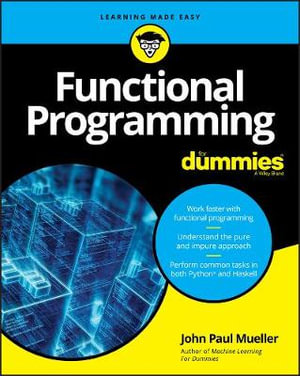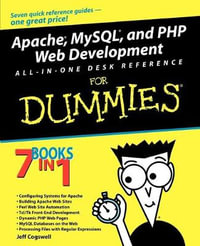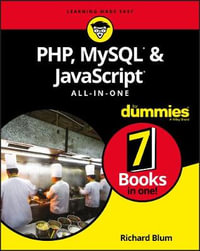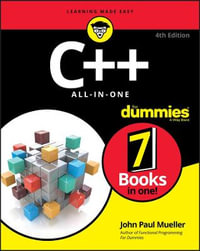
Instant online reading.
Don't wait for delivery!
Go digital and save!
Functional Programming For Dummies
Paperback | 18 January 2019 | Edition Number 1
At a Glance
320 Pages
23.5 x 19.0 x 1.5
Paperback
RRP $49.95
$38.75
22%OFF
or 4 interest-free payments of $9.69 with
orAims to ship in 7 to 10 business days
When will this arrive by?
Enter delivery postcode to estimate
Your guide to the functional programming paradigm
Functional programming mainly sees use in math computations, including those used in Artificial Intelligence and gaming. This programming paradigm makes algorithms used for math calculations easier to understand and provides a concise method of coding algorithms by people who aren't developers. Current books on the market have a significant learning curve because they're written for developers, by developers -until now.
Functional Programming for Dummies explores the differences between the pure (as represented by the Haskell language) and impure (as represented by the Python language) approaches to functional programming for readers just like you. The pure approach is best suited to researchers who have no desire to create production code but do need to test algorithms fully and demonstrate their usefulness to peers. The impure approach is best suited to production environments because it's possible to mix coding paradigms in a single application to produce a result more quickly. Functional Programming For Dummies uses this two-pronged approach to give you an all-in-one approach to a coding methodology that can otherwise be hard to grasp.
- Learn pure and impure when it comes to coding
- Dive into the processes that most functional programmers use to derive, analyze and prove the worth of algorithms
- Benefit from examples that are provided in both Python and Haskell
- Glean the expertise of an expert author who has written some of the market-leading programming books to date
If you're ready to massage data to understand how things work in new ways, you've come to the right place!
Introduction 1
About This Book 1
Foolish Assumptions 3
Icons Used in This Book 3
Beyond the Book 4
Where to Go from Here 5
Part 1: Getting Started with Functional Programming 7
Chapter 1: Introducing Functional Programming 9
Defining Functional Programming 10
Understanding its goals 11
Using the pure approach 11
Using the impure approach 12
Considering Other Programming Paradigms 13
Imperative 13
Procedural 13
Object-oriented 14
Declarative 14
Using Functional Programming to Perform Tasks 15
Discovering Languages That Support Functional Programming 16
Considering the pure languages 16
Considering the impure languages 17
Finding Functional Programming Online 17
Chapter 2: Getting and Using Python 19
Working with Python in This Book 20
Creating better code 20
Debugging functionality 20
Defining why notebooks are useful 21
Obtaining Your Copy of Anaconda 21
Obtaining Analytics Anaconda 21
Installing Anaconda on Linux 22
Installing Anaconda on MacOS 23
Installing Anaconda on Windows 24
Understanding the Anaconda package 26
Downloading the Datasets and Example Code 27
Using Jupyter Notebook 28
Defining the code repository 28
Getting and using datasets 33
Creating a Python Application 34
Understanding cells 35
Adding documentation cells 36
Other cell content 38
Running the Python Application 38
Understanding the Use of Indentation 39
Adding Comments 41
Understanding comments 41
Using comments to leave yourself reminders 43
Using comments to keep code from executing 43
Closing Jupyter Notebook 44
Getting Help with the Python Language 45
Chapter 3: Getting and Using Haskell 47
Working with Haskell in This Book 48
Obtaining and Installing Haskell 48
Installing Haskell on a Linux system 50
Installing Haskell on a Mac system 50
Installing Haskell on a Windows system 52
Testing the Haskell Installation 54
Compiling a Haskell Application 56
Using Haskell Libraries 59
Getting Help with the Haskell Language 60
Part 2: Starting Functional Programming Tasks 63
Chapter 4: Defining the Functional Difference 65
Comparing Declarations to Procedures 66
Understanding How Data Works 67
Working with immutable data 68
Considering the role of state 68
Eliminating side effects 69
Seeing a Function in Haskell 69
Using non-curried functions 69
Using curried functions 70
Seeing a Function in Python 73
Creating and using a Python function 73
Passing by reference versus by value 74
Chapter 5: Understanding the Role of Lambda Calculus 77
Considering the Origins of Lambda Calculus 78
Understanding the Rules 80
Working with variables 80
Using application 81
Using abstraction 82
Performing Reduction Operations 85
Considering α-conversion 85
Considering β-reduction 86
Considering η-conversion 88
Creating Lambda Functions in Haskell 89
Creating Lambda Functions in Python 89
Chapter 6: Working with Lists and Strings 91
Defining List Uses 92
Creating Lists 93
Using Haskell to create Lists 94
Using Python to create lists 95
Evaluating Lists 96
Using Haskell to evaluate Lists 97
Using Python to evaluate lists 99
Performing Common List Manipulations 100
Understanding the list manipulation functions 101
Using Haskell to manipulate lists 101
Using Python to manipulate lists 102
Understanding the Dictionary and Set Alternatives 103
Using dictionaries 103
Using sets 104
Considering the Use of Strings 105
Understanding the uses for strings 105
Performing string-related tasks in Haskell 106
Performing string-related tasks in Python 106
Part 3: Making Functional Programming Practical 109
Chapter 7: Performing Pattern Matching 111
Looking for Patterns in Data 112
Understanding Regular Expressions 113
Defining special characters using escapes 114
Defining wildcard characters 115
Working with anchors 115
Delineating subexpressions using grouping constructs 116
Using Pattern Matching in Analysis 117
Working with Pattern Matching in Haskell 118
Performing simple Posix matches 118
Matching a telephone number with Haskell 120
Working with Pattern Matching in Python 121
Performing simple Python matches 121
Doing more than matching 123
Matching a telephone number with Python 124
Chapter 8: Using Recursive Functions 125
Performing Tasks More than Once 126
Defining the need for repetition 126
Using recursion instead of looping 127
Understanding Recursion 128
Considering basic recursion 129
Performing tasks using lists 131
Upgrading to set and dictionary 132
Considering the use of collections 134
Using Recursion on Lists 135
Working with Haskell 135
Working with Python 136
Passing Functions Instead of Variables 137
Understanding when you need a function 138
Passing functions in Haskell 138
Passing functions in Python 139
Defining Common Recursion Errors 140
Forgetting an ending 140
Passing data incorrectly 141
Defining a correct base instruction 141
Chapter 9: Advancing with Higher-Order Functions 143
Considering Types of Data Manipulation 144
Performing Slicing and Dicing 146
Keeping datasets controlled 146
Focusing on specific data 147
Slicing and dicing with Haskell 147
Slicing and dicing with Python 150
Mapping Your Data 151
Understanding the purpose of mapping 151
Performing mapping tasks with Haskell 152
Performing mapping tasks with Python 153
Filtering Data 154
Understanding the purpose of filtering 154
Using Haskell to filter data 155
Using Python to filter data 156
Organizing Data 157
Considering the types of organization 157
Sorting data with Haskell 158
Sorting data with Python 159
Chapter 10: Dealing with Types 161
Developing Basic Types 162
Understanding the functional perception of type 162
Considering the type signature 162
Creating types 164
Composing Types 170
Understanding monoids 170
Considering the use of Nothing, Maybe, and Just 174
Understanding semigroups 176
Parameterizing Types 176
Dealing with Missing Data 178
Handling nulls 178
Performing data replacement 180
Considering statistical measures 180
Creating and Using Type Classes 181
Part 4: Interacting in Various Ways 183
Chapter 11: Performing Basic I/O 185
Understanding the Essentials of I/O 186
Understanding I/O side effects 186
Using monads for I/O 188
Interacting with the user 188
Working with devices 189
Manipulating I/O Data 191
Using the Jupyter Notebook Magic Functions 192
Receiving and Sending I/O with Haskell 195
Using monad sequencing 195
Employing monad functions 195
Chapter 12: Handling The Command Line 197
Getting Input from the Command Line 198
Automating the command line 198
Considering the use of prompts 198
Using the command line effectively 199
Accessing the Command Line in Haskell 200
Using the Haskell environment directly 200
Making sense of the variety of packages 201
Obtaining CmdArgs 202
Getting a simple command line in Haskell 204
Accessing the Command Line in Python 205
Using the Python environment directly 205
Interacting with Argparse 206
Chapter 13: Dealing With Files 207
Understanding How Local Files are Stored 208
Ensuring Access to Files 209
Interacting with Files 209
Creating new files 210
Opening existing files 211
Manipulating File Content 212
Considering CRUD 213
Reading data 214
Updating data 215
Completing File-related Tasks 217
Chapter 14: Working With Binary Data 219
Comparing Binary to Textual Data 220
Using Binary Data in Data Analysis 221
Understanding the Binary Data Format 222
Working with Binary Data 225
Interacting with Binary Data in Haskell 225
Writing binary data using Haskell 226
Reading binary data using Haskell 227
Interacting with Binary Data in Python 228
Writing binary data using Python 228
Reading binary data using Python 229
Chapter 15: Dealing With Common Datasets 231
Understanding the Need for Standard Datasets 232
Finding the Right Dataset 233
Locating general dataset information 233
Using library-specific datasets 234
Loading a Dataset 236
Working with toy datasets 237
Creating custom data 238
Fetching common datasets 239
Manipulating Dataset Entries 241
Determining the dataset content 241
Creating a DataFrame 243
Accessing specific records 244
Part 5: Performing Simple Error Trapping 247
Chapter 16: Handling Errors in Haskell 249
Defining a Bug in Haskell 250
Considering recursion 250
Understanding laziness 251
Using unsafe functions 252
Considering implementation-specific issues 253
Understanding the Haskell-Related Errors 253
Fixing Haskell Errors Quickly 256
Relying on standard debugging 256
Understanding errors versus exceptions 258
Chapter 17: Handling Errors in Python 259
Defining a Bug in Python 260
Considering the sources of errors 260
Considering version differences 262
Understanding the Python-Related Errors 263
Dealing with late binding closures 263
Using a variable 264
Working with third-party libraries 264
Fixing Python Errors Quickly 265
Understanding the built-in exceptions 265
Obtaining a list of exception arguments 266
Considering functional style exception handling 267
Part 6: The Part of Tens 269
Chapter 18: Ten Must-Have Haskell Libraries 271
binary 271
Hascore 273
vect 273
vector 274
aeson 274
attoparsec 275
bytestring 275
stringsearch 276
text 276
moo 277
Chapter 19: Ten (Plus) Must-Have Python Packages 279
Gensim 280
PyAudio 281
PyQtGraph 282
TkInter 283
PrettyTable 283
SQLAlchemy 284
Toolz 284
Cloudera Oryx 285
funcy 285
SciPy 286
XGBoost 287
Chapter 20: Ten Occupation Areas that Use Functional Programming 289
Starting with Traditional Development 289
Going with New Development 290
Creating Your Own Development 291
Finding a Forward-Thinking Business 292
Doing Something Really Interesting 292
Developing Deep Learning Applications 293
Writing Low-Level Code 293
Helping Others in the Health Care Arena 294
Working as a Data Scientist 294
Researching the Next Big Thing 295
Index 297
ISBN: 9781119527503
ISBN-10: 1119527503
Series: For Dummies (Computer/Tech)
Published: 18th January 2019
Format: Paperback
Language: English
Number of Pages: 320
Audience: General Adult
Publisher: John Wiley & Sons Inc (US)
Country of Publication: GB
Edition Number: 1
Dimensions (cm): 23.5 x 19.0 x 1.5
Weight (kg): 0.43
Shipping
| Standard Shipping | Express Shipping | |
|---|---|---|
| Metro postcodes: | $9.99 | $14.95 |
| Regional postcodes: | $9.99 | $14.95 |
| Rural postcodes: | $9.99 | $14.95 |
How to return your order
At Booktopia, we offer hassle-free returns in accordance with our returns policy. If you wish to return an item, please get in touch with Booktopia Customer Care.
Additional postage charges may be applicable.
Defective items
If there is a problem with any of the items received for your order then the Booktopia Customer Care team is ready to assist you.
For more info please visit our Help Centre.























